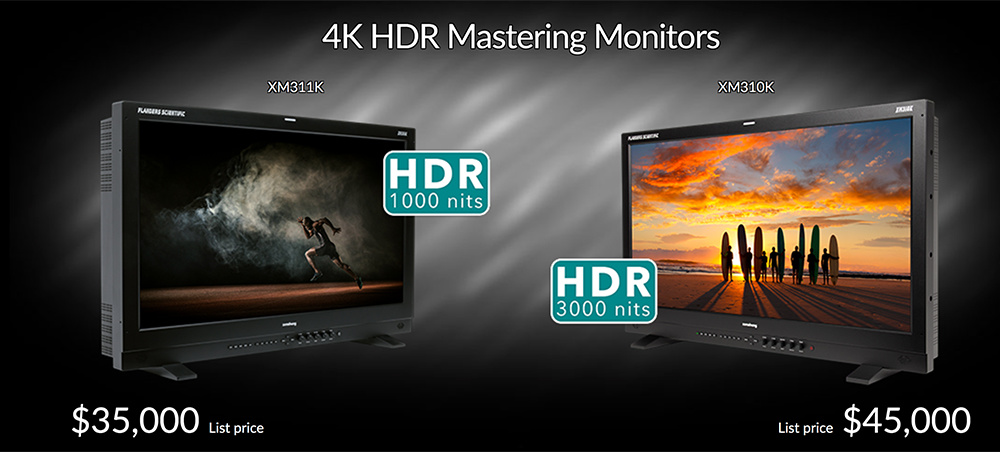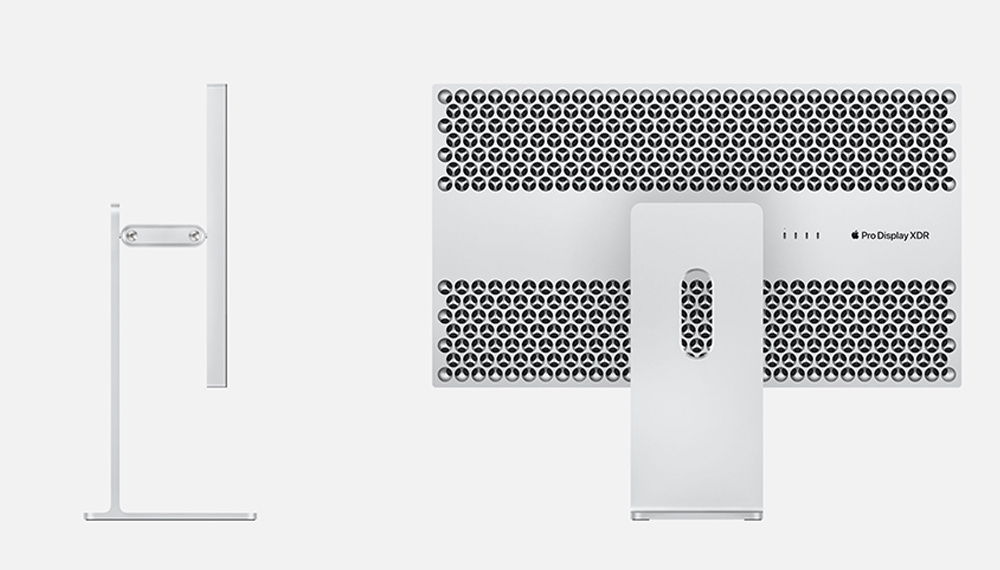You might not be considering dropping the cash for this thing, but the target customer might.
If you’re out of the loop, Apple announced a brand new Mac Pro. It’s an overdue replacement for the previous trash can model, and I think Apple is getting back to their Mac Pro roots. It’s more cheese grater than ever.
In addition, we’re finally getting an update to the old Cinema Display that many loved. For the past couple years, Apple stopped selling these and instead touted LG’s 5K display. The latest Pro Display XDR offering is as in-house Apple as it gets, even down to the eye-watering price. The new 10-bit 6K monitor will cost $4,999, or for $1,000 more, you can get fancy new reflection-phobic glass.

If Apple's monitor is as good as they say it is, then it competes with the best. These are comparable Flanders Scientific reference monitors.
Your Display Isn’t This Display
I’ve said for a few years now that HDR is the future. When Apple debuted the iPhone X, nearly all of the lauded features pertained to watching HDR content. Netflix is behind it, HBO dropped the ball on it with Game of Thrones, and content producers need to get on board.
Unfortunately, reference monitors aren’t all the same, and newer standards like HDR10 and Dolby Vision can only be achieved with a certain class of display. That wouldn’t be a problem if these things were cheap, but an industry standard Flanders Scientific monitor will seriously set you back, and you'll want it to last years. A Flanders that’s comparable to Apple’s Pro Display XDR would cost $35,000 and would be 4K instead of 6K.
A side note here that I prefer a true 16x9 4K reference monitor so there’s no upscaling from a 4K signal. Still, 6K is impressive and will be amazing for photographers.
The Competition
Two years ago, I reviewed Atomos’ Sumo monitor/recorder, a wonderful piece of kit that gave me hope for the future of HDR. It had a 10-bit FRC, 1,200 nit display and all the bells and whistles you could need on set: focus peaking, waveforms, the lot. The display-only version costs about $1,300 right now.
However, it’s not true 10-bit. It’s 8+2-bit. Here’s a brief explanation of that. While some might not notice the difference, Atomos certainly have. That’s why they’ve released all new 10-bit HDR monitors that directly compete with their Sumo, the Atomos NEON.
If we were to pick the new Atomos NEON monitor that matched Apple’s Pro Display the best, it would be the 31” model. This monitor comes in at $7,999. Granted, Atomos packs this monitor with way more I/O, a 4K 10-bit recorder, waveforms, LUTS, and even an accompanying app. But I hope you still see what the asking price for a good HDR monitor is.

Atomos' new NEON line up is a competitor with Apple's Pro Display XDR, although they are so much more than just a display.
Non-Issues
Now I don’t think that Apple’s Pro Display really matches exactly to a Flanders or Sony reference monitor. You don’t get built-in scopes, LUT control, or any features that might help on set. They also say that the Pro Display “produces an industry-leading 1,000 nits,” which is and isn’t true. That 1,000-nit $35k Flanders monitor I mentioned earlier has a $45k bigger brother, which peaks at 3,000 nits.
I’m being extremely nit-picky here though, because that Flanders monitor can only display the 3,000 nit image at a 20% scale. So, you’re only getting a small fraction of usable screen. This won’t happen with Apple’s monitor.
What also won’t happen with the Pro Display is full performance when it’s warm. Apple is claiming that it’ll sustain at 1,000 nits and have a peak of 1600 nits. That brighter ability won’t kick in if the monitor is over 25 °C. Interesting that they’d dish out a temperature in Celsius on their US website. That’s 77 °F, so comfortably above room temperature. This isn’t a particularly jarring issue, I feel, but I’ll bet people will complain about it and compare it to the MacBook Pro’s i9 chip overheating.

The lack of HDMI or SDI sets the Pro Display aside from other reference monitors, and it irks me. This is designed to be plugged into a Mac computer.
Industry Adoption
Apple makes a bold point here. They think that if everybody buys these monitors and they overtake the existing industry standard, then the industry will be better off. They’re totally right, in the sense that a colorist or retoucher knows that they’re looking at the same monitor that was used on set.
If industry juggernauts start advertising their tools with the Pro Display, then there’s even more reason to buy it. I’m talking about color calibration tools like Spyder, waveform display apps like Scopebox, and editing apps from Davinci Resolve and Lightroom (who have both already been mentioned in Apple’s keynote).
Also, I know it’s petty, but most of us like when a client recognizes and appreciates our tools, from a particular lens to a type of light. Does a client always know the difference between a softbox and a parabolic? No, but they might know the difference in quality. I’m sure we’ll be seeing these displays in high-end studios soon, and I’m sure that some of the appeal will be the client seeing a brand they know and trust.
Pros have called on Apple to provide updated gear for years, and it’s finally happened. I’m going to brush off the comments that they’ve missed the mark here. Although, I just can’t get behind a $1,000 monitor stand.
What do you think? Will you be saving up or renting one for a few days? Or do the likes of Atomos, Flanders Scientific, and Sony seem more reputable to you?







Probably not for a long time. Reference monitors with specs like this are usually extremely expensive. Most creatives do not need them, but some do - especially color graders and those that work on HDR10 content. I can't find any NEC HDR reference monitors, and EIZO only got one with competing specs - the ColorEdge PROMINENCE CG3145, which costs around $30,000.
ASUS ProArt PA32UCX may become a decent alternative at around $4000, but it's difficult to find any hard specs on sustained brightness values, only typical or peak.
Again...this new MAC Pro and Monitor is not for "US"
They are going to charge $1K for the monitor stand...but give you the cleaning cloth as part of the monitor sale??
No thanks...keep the cleaning cloth. Throw in the monitor stand.
This is pretty much for the Hollywood studio game. Nobody needs this for Youtube..and anything equivalent.
So everybody that owns a monitor of less than 5000$ can't produce decent images and video?? Really??
Protip: If people have to write an article after the fact to convince you that it's worth it, it's probably not worth it.
I love how he says the closest competition to their monitor is a 10-bit video RECORDER / reference monitor that is, by definition, twice the equipment, not a valid comparison. Of course it's going to cost substantially more. For an actual comparison try an EIZO or NEC reference monitor. You can pick up 4k 32 inch models for around 1 grand and they are actual professional reference monitors.
4K is common for professionals who use multiple monitors, but 6K is common for processionals who use one monitor. That way, 4k video can play at native resolution in the video editing software while all the controls and menus are around it.
I am patiently waiting for the "I can build one of those for like $650" posts....
has been already calculated :) .. it is roughly half of the price (for base Mac Pro) ..well with nVidia obviously ;)
But that doesnt really matter if you wanna use FinalCut or if you are too much into OS ..
Guys, what about calibrating this new Apple monitor? I mean, does this have any buttons, options to set RGB, contrast, etc... Previous Apple monitors, iMac doesn't have the option... Or at this category factory calibrated and that's all? I haven't seen any Apple screen coming with the right WB from factory...
My humble opinion, all I have seen is articles about this screen and the Mac Pro... it seems the whole world has failed to notice they are now allowing network drive access from the files app on iPad (think editing on the fly and uploads to social media with greater ease). Also failed to notice that the sidecar app coming to iPad will allow 2nd screen on a Mac so you can use editing tools with the Apple Pencil seamlessly.
For $5k.. I can find plenty of things that are worth more, like amazing glass.
I can't see why people can honestly support Apple's pricing of their products.
https://www.engadget.com/2019/06/04/apple-pro-display-xdr-stand/?guccoun...
This is correct. $999 extra for the needed stand is everything that is wrong with Apple today.
Again, catalog this in the people with more money than sense column.
For a very select part of the market, this is indeed a bargain. For those customers who would normally spend 30-50k on a reference monitor. For everyone else, this is probably far too expensive.
The Mac Pro in the rather shitty base configuration is good for nobody with a working mind. Knowing Apple, a bit specced up version will probably cost more than 15-20k and this makes is also far too expensive for most photographers and most small video firms.
The large studios with millions in equipment will of course spend 50k without a problem it is suits their needs.
1. Who's grading at full brightness? Eye fatigue is a thing. Dark room and medium/low brightness.
2. No scopes on the Apple monitor.
"I’m talking about color calibration tools like Spyder"
I've worked in broadcast and post. Never seen a production monitor that only came with USB C ports.
Most come with SDI, HDMI, Displayport, maybe component and more HDMI.
But in Apple's universe, you are only plugging it into their computers, using their software and streaming to iDevices.
At least the article mentions the lack of LUTs, scopes (and LUFS meters).
This is just very expensive prosumer.